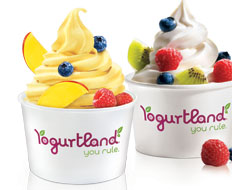Yogurtland offers dozens of frozen yogurt flavors, such as citrus varieties like Blackberry Lemon Mint Tart, Blood Orange Tart, and Key Lime Bar Tart, to diners who can’t seem to get enough of the fro-yo craze.
With 16 flavors and more than 30 toppings available at any given time, Yogurtland is “a yogurt buffet,” says Phillip Chang, founder and CEO of the concept.
“I wanted to have as many flavors as possible,” he says.
Chang got his start with Boba Loca, a bubble tea concept. He added self-serve frozen yogurt as an afterthought.
“I discovered the potential of the self-serve concept,” he says. “The power and control of the customers made them so happy, I sold my old company and spent about a year re-engineering the concept. I changed the U.S. frozen yogurt business model by seeing that self-serve is the right way to go.”
The first Yogurtland opened in May 2007. By the end of that year there were three locations open, and by the end of 2011, there were 171.
“Our future goal is to hit 1,000 stores by the end of 2017,” Chang says. “We started from the West, and our growth will continue to be very strong in the West, but we will be all over the country. We have a very specific growth plan. We have 10 or 15 specific areas we’ve chosen and we’ll go there first. We’re selective and we make sure all of our stores are aligned and all of our franchisees can make it.”
With an average of 600 customers a day per store, the company sees a lot of frozen yogurt mixed into seemingly endless combinations of flavors and toppings.
Yogurtland
CEO: Phillip Chang
HQ: Anaheim, California
Year Started: 2006
Annual Sales: $100 million
Total Units: 173
Franchise Units: 165
Chang says that priced at about 33 cents per ounce, Yogurtland’s frozen yogurt is a better value for consumers than competitors who dish up their product from behind a counter. But the first couple of times customers serve themselves, he says, they are overly generous.
“People tend to take a little more at first because there are just so many choices and they want to try a little bit of this and a little bit of that,” Chang says. “The first few times they get extra, but when they know what they want, they get the exact flavor and amount to satisfy them.”
Yogurtland’s self-service concept is simple: Customers enter the store and choose either a 16- or 24-ounce cup from a dispenser. Next to the cup dispenser is a wall of eight yogurt machines with two flavors each.
“Eight to 10 of the flavors are always available; the rest are seasonal,” Chang says. “We introduce two new flavors every other month. All of our recipes are developed internally.”
Next to the yogurt machines, customers find the extensive toppings bar with everything from fresh fruits to gummy bears, cookies, and sprinkles.
“We have oranges, blackberries, blueberries, strawberries … whatever you like,” Chang says. “Little kids go for the chocolate, cookies, and candy, and the adults like the fruits.”
After choosing their toppings, customers head to the scale and cash register, where an employee weighs the creation and takes payment. To keep traffic moving, two registers are always in operation.
Chang says the fruit toppings are also a good value for customers, especially in winter, when blackberries can cost as much as 50 cents an ounce.
“In the wintertime, the price of blueberries or raspberries can really go up,” he says. “We just can’t afford it when it goes higher than $1 an ounce, so then we have to be creative and offer different toppings.”
Chang says Yogurtland customers are very active in providing the company feedback, whether in person at the stores or on social networking sites.
“We’re always working hard to accommodate customer requests,” he says. “But we can only have 16 flavors, and that’s challenging. Customers don’t like to see flavors go away, so that’s a constant problem we have.”
Chang says Yogurtland does not do much traditional marketing.
“My thinking is that the customer line out the door is the best marketing,” he says. “If we show customers what we have in the store, they do everything else. If we concentrate on product quality and value, our customers will do the rest of it.”
Besides word of mouth and social networking, another simple marketing tool Yogurtland takes advantage of is its spoon.
“Fifteen million spoons are used a year in our stores,” Chang says. “So we made our spoon really substantial. All the customers notice the spoons and they keep them. … They have them in their kitchen drawers.”
Chang says the fact that Yogurtland’s signature spoons are reusable makes them “green,” something that he says is important to his business fundamentals.
“I can’t accept something that is used once and thrown away,” he says. “It doesn’t go with my philosophy of frugality.”
Another bonus: “Little kids love the spoon,” Chang says, making the one in the kitchen drawer a constant reminder of Yogurtland.







